 W
WBreakfast is the meal eaten in the morning. The word in English refers to breaking the fasting period of the previous night. There is a strong likelihood for one or more "typical", or "traditional", breakfast menus to exist in most places, but their composition varies widely from place to place, and has varied over time, so that globally a very wide range of preparations and ingredients are now associated with breakfast.
 W
WThis is an index of breakfast-related articles. Breakfast is the first meal taken after rising from a night's sleep, most often eaten in the early morning before undertaking the day's work. Among English speakers, "breakfast" can be used to refer to this meal, or to a meal composed of traditional breakfast foods served at any time of day.
 W
WAn apple dumpling is a baked or boiled pastry-wrapped apple. To prepare apple dumplings, apples are peeled, cored and sometimes quartered and placed on a portion of dough. The hole from the core may be filled with cinnamon, butter and sugar and sometimes dried fruit such as raisins, sultanas, or currants. The dough is folded over the apples and sealed. Sometimes a spiced sauce is poured over the dumplings which are then baked until tender; the sugar and butter create a sweet sauce. Apple dumplings can be served hot, cold, or room temperature for breakfast, dessert, or as a main dish.
 W
WBiscuits and gravy is a popular breakfast dish in the United States, especially in the South. The dish consists of soft dough biscuits covered in either sawmill or meat gravy, made from the drippings of cooked pork sausage, white flour, milk, and often bits of sausage, bacon, ground beef, or other meat. The gravy is often flavored with black pepper.
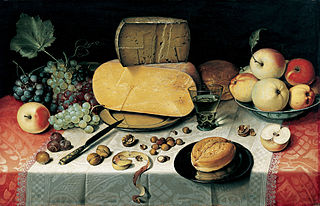 W
WBrunch is a combination of breakfast and lunch, and regularly has some form of alcoholic drink served with it. It is usually served anytime before 3 o'clock in the afternoon. The word is a portmanteau of breakfast and lunch. Brunch originated in England in the late 19th century and became popular in the United States in the 1930s.
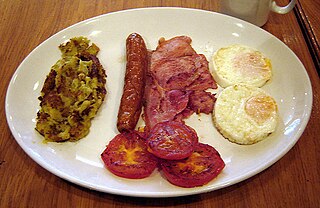 W
WBubble and squeak is a British dish made from cooked potatoes and cabbage, mixed together and fried. The food writer Howard Hillman classes it as one of the "great peasant dishes of the world". The dish has been known since at least the 18th century, and in its early versions it contained cooked beef. By the mid-20th century the two vegetables had become the principal ingredients.
 W
WCalas are dumplings composed primarily of cooked rice, yeast, sugar, eggs, and flour; the resulting batter is deep-fried. It is traditionally a breakfast dish, served with coffee or cafe au lait, and has a mention in most Creole cuisine cookbooks. Calas are also referred to as Creole rice fritters or rice doughnuts.
 W
WBreakfast cereal is a traditional breakfast made from processed cereal grains. It is traditionally eaten as breakfast primarily in Western societies. Warm cereals like porridge and grits have the longest history. Ready-to-eat cold cereals, appearing around the late 19th century, are most often mixed with milk, but can also be paired with yogurt instead or eaten plain. Fruit or nuts are sometimes added. Many breakfast cereals are produced via extrusion. Some companies promote their products for the health benefits that come from eating oat-based and high-fiber cereals. In the United States, cereals are often fortified with vitamins but can still lack many of the vitamins needed for a healthy breakfast. A significant proportion of cereals are made with high sugar content. Many are marketed towards children, feature a cartoon mascot, and may contain a toy or prize.
 W
WA champagne breakfast is a breakfast served with champagne or sparkling wine. It is a new concept in some countries and is not typical of the role of a breakfast.
 W
WDim sum is a large range of small dishes that Cantonese people traditionally enjoy in restaurants for breakfast and lunch. In the tenth century, when the city of Guangzhou (Canton) began to experience an increase in commercial travel, travelers concurrently began to frequent teahouses for small-portion meals with tea called yum cha, or "drink tea" meals. Yum cha includes two related concepts. The first is Yat jung Leung gin (一盅兩件), which translates literally as "one cup, two pieces". This refers to the custom of serving teahouse customers two pieces of delicately made food items, savory or sweet, to complement their tea. The second is dim sum (點心) and translates literally to "touching heart", the term used to designate the small food items that accompanied the tea drinking.
 W
WElevenses is a short break taken at around 11:00a.m. to consume a drink or snack. The names and details vary among countries.
 W
WFatoot samneh is a dish originating in Yemeni cuisine, consisting of pieces of saluf or malawach, or pita, that have been fried in clarified butter and combined with beaten egg. It is commonly served as a breakfast or dinner dish. It was brought to Israel by Yemenite Jews. It is somewhat similar to the Jewish matzah brei or the Mexican-American migas, which are made with matzo, and corn tortillas, respectively; whereas fatoot samneh is made with pita bread.
 W
WA full breakfast is a substantial cooked breakfast meal, often served in the United Kingdom and Ireland, that typically includes bacon, sausages, eggs, black pudding, baked beans, tomatoes and mushrooms, toast, and a beverage such as coffee or tea. It appears in different regional variants and is referred to by different names depending on the area. While it is colloquially known as a "fry up" in most areas of Britain and Ireland, it is usually referred to as a full English breakfast in England, and as a "full Irish", "full Scottish", "full Welsh", "full Cornish", and "Ulster fry" in the Republic of Ireland, Scotland, Wales, Cornwall, and Northern Ireland, respectively.
 W
WGoetta is a meat-and-grain sausage or mash of German inspiration that is popular in the greater Cincinnati area. It is primarily composed of ground meat, pin-head oats and spices. It was originally a dish meant to stretch out servings of meat over several meals to conserve money, and is a similar dish to scrapple and livermush, both also developed by German immigrants.
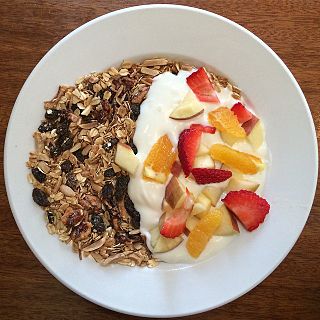 W
WGranola is a breakfast food and snack food consisting of rolled oats, nuts, honey or other sweeteners such as brown sugar, and sometimes puffed rice, that is usually baked until it is crisp, toasted and golden brown. During the baking process, the mixture is stirred to maintain a loose breakfast cereal consistency. Dried fruit, such as raisins and dates, and confections such as chocolate are sometimes added. Granola is often eaten in combination with yogurt, honey, fresh fruit, milk or other forms of cereal. It also serves as a topping for various pastries, desserts or ice cream.
 W
WHam and eggs is a dish combining various preparations of its main ingredients, ham and eggs. It has been described as a staple of "an old-fashioned American breakfast" and of the traditional English breakfast. It is also served as a lunch and dinner dish. Some notable people have professed an affinity with the dish, such as Duncan Hines and Henry Puyi. Similar dishes include bacon and eggs, Spanish eggs, the Denver omelette and Eggs Benedict.
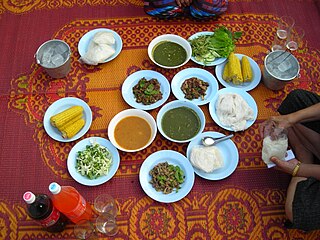 W
WBreakfast is the first meal taken after rising from a night's sleep, most often eaten in the early morning before undertaking the day's work. It was not until the 15th century that "breakfast" came into use in written English to describe a morning meal, which literally means to break the fasting period of the prior night; in Old English the term was morgenmete meaning "morning meal."
 W
WAn Israeli breakfast is a distinctive style of breakfast that originated on the Israeli collective farm called a kibbutz, and is now served at most hotels in Israel and many restaurants.
 W
WJianbing is a traditional Chinese street food similar to crepes. It is a type of bing generally eaten for breakfast and hailed as "one of China's most popular street breakfasts." The main ingredients of jianbing are a batter of wheat and grain flour, eggs and sauces. It can be topped with different fillings and sauces such as baocui, ham, chopped or diced mustard pickles, scallions and coriander, chili sauce or hoisin sauce depending on personal preference. It is often folded several times before serving.
 W
WJianbing guozi is a "deep-fried dough sticks rolled in a thin pancake" of Chinese origin. It is a sub-category of Jianbing. Originated in Tianjin, it is a popular street food and has been hailed as "one of China's most beloved street breakfasts", especially in Tianjin and neighboring Hebei province. It consists of mung bean, eggs, and youtiao or crispy "dragons", served with sweet bean sauce, diced green onion, and optionally chili sauce.
 W
WKatogo is a traditional breakfast dish in Uganda. It is served in most regions of Uganda and is defined as a mixture of ingredients. The main ingredients of the dish are matooke and a sauce
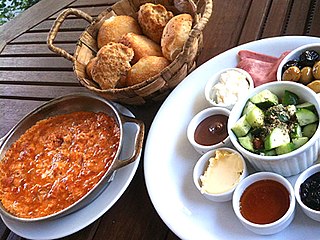 W
WMenemen is a traditional Turkish dish which includes eggs, tomato, green peppers, and spices such as ground black and red pepper cooked in olive oil or sunflower oil. White cheese, and charcuterie products such as sucuk or pastırma may also be added. Menemen may be made with onions, but the addition of onions is often debated and is more common when menemen is eaten as a main dish, rather than at breakfast. The dish is similar to shakshouka.
 W
WMidnight breakfast is a generic term for a communal meal served at some American colleges and universities, often served during finals week. Menu items that are generally considered breakfast foods are served in the school's dining hall late at night as a study break before or during final exams, or as a traditional community-building event. Sometimes food is served by faculty and staff. Midnight breakfast is an occasional event and should not be confused with school dining facilities that operate 24 hours a day on a regular basis.
 W
WMuesli is a cold oatmeal dish based on rolled oats and ingredients like grains, nuts, seeds and fresh or dried fruits. This mix may be combined with one or more liquids like water, milk, plant milks, yogurt, or fruit juice and left for a time to soften the oats before being consumed.
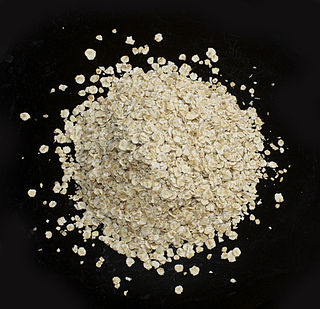 W
WOatmeal is a type of coarse flour made of hulled oat grains (groats) that have either been milled (ground) or steel-cut. Ground oats are also called "white oats". Steel-cut oats are known as "coarse oatmeal", "Irish oatmeal" or "pinhead oats". Rolled oats can be either thick or thin, and may be categorized as "old-fashioned", "quick", or "instant", depending on the cooking time, which is shortened by the size of the oats, precooking, and sometimes the addition of enzymes.
 W
WIn cuisine, an omelette or omelet is a dish made from beaten eggs, fried with butter or oil in a frying pan. It is quite common for the omelette to be folded around fillings such as cheese, chives, vegetables, mushrooms, meat, or some combination of the above. Whole eggs or egg whites are often beaten with a small amount of milk, cream, or water.
 W
WThe Oslo breakfast was a type of uncooked school meal developed in the 1920s and rolled out as a free universal provision for Oslo school children in 1932. It typically consisted of bread, cheese, milk, half an apple and half an orange.
 W
WA pancake is a flat cake, often thin and round, prepared from a starch-based batter that may contain eggs, milk and butter and cooked on a hot surface such as a griddle or frying pan, often frying with oil or butter. Archaeological evidence suggests that pancakes were probably the earliest and most widespread cereal food eaten in prehistoric societies.
 W
WA pancake breakfast is a public meal attached to many festivals, religious celebrations, and community events which involves volunteers cooking large quantities of pancakes and other hot breakfast foods for the general public, often for free or for a nominal charge if the event is a fundraiser.
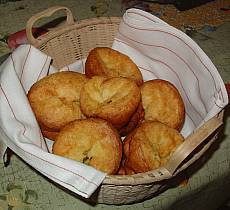 W
WA popover is a light roll made from an egg batter similar to that of Yorkshire pudding, typically baked in muffin tins or dedicated popover pans, which have straight-walled sides rather than angled.
 W
WPorridge is a food commonly eaten as a breakfast cereal dish, made by boiling ground, crushed or chopped starchy plants—typically grain—in water or milk. It is often cooked or served with added flavorings such as sugar, honey, (dried) fruit or syrup to make a sweet cereal, or it can be mixed with spices, meat or vegetables to make a savoury dish. It is usually served hot in a bowl, depending on its consistency. Oat porridge, or oatmeal, is one of the most common types of porridge. Gruel is a thinner version of porridge.
 W
WRolled oats are a type of lightly processed whole-grain food. Traditionally, they are made from oat groats that have been dehusked and steamed, before being rolled into flat flakes under heavy rollers and then stabilized by being lightly toasted.
 W
WRösti or rööschti is a Swiss dish consisting mainly of potatoes, in the style of a fritter. It was originally a breakfast dish, commonly eaten by farmers in the canton of Bern, but is now eaten all over Switzerland and around the world. The French name röstis bernois makes direct reference to the origins of the dish.
 W
WSausage gravy is a traditional Southern breakfast dish in the United States. After loose pork sausage is cooked in a pan and removed, a roux is formed by browning flour in the residual fat. Milk and seasonings, such as salt and pepper, are added to create a moderately thick gravy, to which the cooked sausage is added. Occasionally, ingredients such as cayenne pepper or a spicy sausage are used to make a spicier gravy.
 W
WSecond breakfast is a meal eaten after breakfast, but before lunch. It is a traditional meal in Bavaria, Poland, Slovakia, Spain and Hungary. In Bavaria and Poland, special dishes are made exclusively to be eaten during second breakfast. In Vienna and most other parts of Austria the second breakfast is referred to as Jause. In other Spanish-speaking countries, almuerzo means lunch, but in Spain it is a second breakfast. It is typical to eat four to five meals a day in these locations.
 W
WShaobing, also called huoshao, is a type of baked, unleavened, layered flatbread in Northern Chinese cuisine. Shaobing can be made with or without stuffing, and with or without sesame on top. Shaobing contains a variety of stuffings that can be grouped into two main flavors: savory or sweet. Some common stuffings include red bean paste, black sesame paste, stir-fried mung beans with egg and tofu, braised beef, smoked meat, or beef or pork with spices.
 W
WShengjian mantou, shengjian bao, or shengjian for short, is a type of small, pan-fried baozi which is a specialty of Shanghai. It is typically filled with pork and gelatin that melts into soup/liquid when cooked. It has been one of the most common breakfast items in Shanghai since the early 1900s. As a ubiquitous breakfast item, it has a significant place in Shanghai cuisine.
 W
WSahūr or Sahoor, also called Sahari or Sehri is the meal consumed early in the morning by Muslims before fasting (sawm), before dawn during or outside the Islamic month of Ramadan. The meal is eaten before fajr prayer. Sahur is matched to iftar as the evening meal, during Ramadan, replacing the traditional three meals a day, although in some places dinner is also consumed after iftar later during the night.
 W
WTortang talong, also known as eggplant omelette, is a Filipino omelette made by pan-frying grilled whole eggplants dipped in an egg mixture. It is a popular breakfast and lunch meal in the Philippines. A common variant of tortang talong is rellenong talong, which is stuffed with meat, seafood, and/or vegetables.
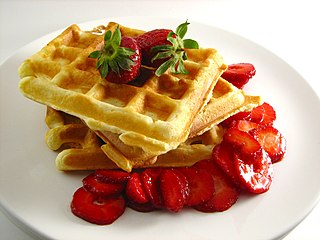 W
WA waffle is a dish made from leavened batter or dough that is cooked between two plates that are patterned to give a characteristic size, shape, and surface impression. There are many variations based on the type of waffle iron and recipe used. Waffles are eaten throughout the world, particularly in Belgium, which has over a dozen regional varieties. Waffles may be made fresh or simply heated after having been commercially cooked and frozen.
 W
WA wedding breakfast is a feast given to the newlyweds and guests after the wedding, making it equivalent to a wedding reception that serves a meal. The phrase is still used in British English.
 W
WYum cha is the Cantonese tradition of brunch involving Chinese tea and dim sum''.The practice is popular in Cantonese-speaking regions, including Guangdong, Guangxi, Hong Kong, and Macau. It is also carried out in other regions worldwide where there are overseas Chinese communities. Yum cha generally involves small portions of steamed, pan-fried, and deep-fried dim sum dishes served in bamboo steamers, which are designed to be eaten communally and washed down with hot tea. People often go to yum cha in large groups for family gatherings and celebrations.